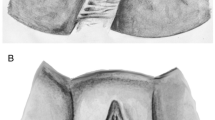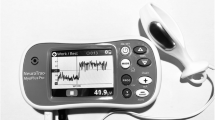Abstract
Introduction and hypothesis
The aim of this study is to compare the Colpexin pull test (CPT) with the Oxford muscle grading scale (OMGS) in assessing pelvic floor muscle strength.
Methods
In phase 1, 15 asymptomatic women underwent OMGS and CPT using three different spheres to select the ideal size. CPT values as well as patient/examiner comfort and ease of CPT performance were recorded. In phase 2, 30 women with stress urinary incontinence underwent CPT and OMGS by two examiners during two separate sessions. Statistical analysis was performed.
Results
In phase 1, the 36-mm sphere was selected based on resting (p < 0.001), contraction CPT (p < 0.001), patient ease (p = 0.018), patient comfort (p = 0.004), and examiner comfort (p < 0.001). In phase 2, there was good intra-rater and inter-rater agreement in maximum CPT. Both tests were positively correlated (r = 0.50, p < 0.001).
Conclusion
CPT is an objective measure of pelvic floor strength and provides consistent, reproducible results.



Similar content being viewed by others
References
Schull BL, Hurt G, Laycock J et al (2002) Physical exam. In: Abrams P, Cardozo L, Khoury S, Wein A (eds) Incontinence. Second International Consultation on Incontinence, Paris, pp 373–388
Kegel AR (1951) Physiologic therapy for urinary stress incontinence. JAMA 146:915–917
Sampselle CM, Miller JM, Mims BL, Delancey JO, Ashton-Miller JA, Antonakos CL (1998) Effect of pelvic muscle exercise on transient incontinence during pregnancy and after birth. Obstet Gynecol 91:406–412
Kegel AR (1948) Progressive resistance exercise in the functional restoration of the perineal muscles. Am J Obstet Gynecol 56:238–248
Hundley AF, Wu JM, Visco AG (2005) A comparison of perineometer to brink score for assessment of pelvic floor muscle strength. Am J Obstet Gynecol 192:1583–1591
Isherwood PJ, Rane A (2000) Comparative assessment of pelvic floor strength using a perineometer and digital examination. Br J Obstet Gynaecol 107:1007–1011
Dumoulin C, Bourbonnais D, Lemieux MC (2003) Development of a dynamometer for measuring the isometric force of the pelvic floor musculature. Neurourol Urodyn 22:648–653
Guaderrama NM, Nager CW, Liu J, Pretorius DH, Mittal RK (2005) The vaginal pressure profile. Neurourol Urodyn 24:243–247
Hahn I, Ohlsson B, Lindstrom S (1991) Pelvic elevation force: a new technique to assess pelvic floor function. Neurourol Urodyn 91(10):396–397
Bo K, Finckenhagen HB (2001) Vaginal palpation of pelvic floor muscle strength: inter-test reproducibility and comparison between palpation and vaginal squeeze pressure. Acta Obstet Gynecol Scand 80:883–887
Worth AM, Dougherty MC, McKey PL (1986) Development and testing of the circumvaginal muscles rating scale. Nurs Res 35:166–169
Laycock J, Jerwood D (2001) Pelvic floor muscle assessment: the PERFECT scheme. Physiotherapy 87(12):631–642
Messelink B, Benson T, Berghmans B, Bo K, Corcos J, Fowler C et al (2005) Standardization of terminology of pelvic floor muscle function and dysfunction: report from the Pelvic Floor Clinical Assessment Group of the International Continence Society. Neurourol Urodyn 24:374–380
Adamkiewicz MM, Adamkiewicz MF, Jozwik M, Jozwik M (2001) Combined treatment of pelvic floor exercises and new intravaginal device for genital prolapse. Int Urogynecol J 12:S48
Lukban JC, Aguirre OA, Davila GW, Sand PK (2006) Safety and effectiveness of Colpexin sphere in the treatment of pelvic organ prolapse. Int Urogynecol J Pelvic Floor Dysfunct 17:449–454
Brink CA, Sampselle CM, Wells TJ, Diokno AC, Gillis GL (1989) A digital test for the pelvic muscle strength in older women with urinary incontinence. Nurs Res 38:196–199
Guerette N, Neimark M, Kopka SL, Jones JE, Davila GW (2004) Initial experience with a new method for the dynamic assessment of pelvic floor function in women: the Colpexin pull test. Int Urogynecol J Pelvic Floor Dysfunct 15:39–43
Miller JM, Ashton-Miller JA, Delancey JOL (1998) A pelvic muscle precontraction can reduce cough-related urine loss in selected women with mild SUI. J Am Geriatr Soc 46(7):870–874
Neumann P, Gill V (2002) Pelvic floor and abdominal muscle interaction: EMG activity and intra-abdominal muscles. Int Urogynecol J Pelvic Floor Dysfunct 13:125–132
McVean RJ, Orr AK, Webb AK, Bradbury A, Kay L, Philips E, Dodd ME (2003) Treatment of urinary incontinence in cystic fibrosis. J Cyst Fibrosis 2:171–176
Acknowledgements
This study was funded by Adamed Ltd., Warsaw, Poland. Writing of the manuscript was made solely by the authors listed.
Contribution to authorship
Marjorie Jean-Michel, MD: substantial contribution to the study design; acquisition of data and its interpretation; writing of the manuscript; review of final approval of version to be published.
Daniel H. Biller, MD: contribution to the study design; acquisition of data; revision suggestions for intellectual content; review of final approval of version to be published.
James F. Bena, MS: contribution to the study design; analysis of data; revision suggestions for content; review of final approval of version to be published.
G. Willy Davila, MD: substantial contribution to the initial study concept and design; acquisition of data and its interpretation; critical review of manuscript for intellectual content; review of final approval of version to be published.
Details of ethics approval
This study was approved by the Institutional Review Board (IRB) at Cleveland Clinic Florida on November 8, 2005. The IRB number for this study is 8730.
Conflicts of interest
Marjorie Jean-Michel, Daniel H. Biller, and James F. Bena have no conflicts of interest. G. Willy Davila is a consultant for American Medical Systems (Minnetonka, MN), Astellas (Tokyo, Japan), and Watson (Corona, CA).
Author information
Authors and Affiliations
Corresponding author
Rights and permissions
About this article
Cite this article
Jean-Michel, M., Biller, D.H., Bena, J.F. et al. Measurement of pelvic floor muscular strength with the Colpexin pull test: a comparative study. Int Urogynecol J 21, 1011–1017 (2010). https://doi.org/10.1007/s00192-010-1130-4
Received:
Accepted:
Published:
Issue Date:
DOI: https://doi.org/10.1007/s00192-010-1130-4




